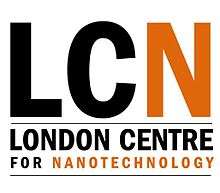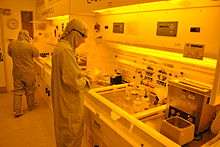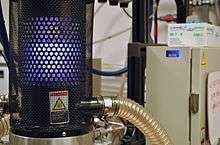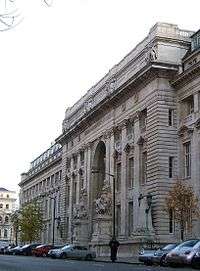London Centre for Nanotechnology
 | |
| Established | 2003 |
|---|---|
| Director |
Professor Gabriel Aeppli Professor Milo Shaffer |
Administrative staff | Around 130 |
| Location | London, United Kingdom |
| Website | London Centre for Nanotechnology |
The London Centre for Nanotechnology is a multidisciplinary research centre in physical and biomedical nanotechnology in London, United Kingdom. It brings together two institutions that are world leaders in nanotechnology, University College London and Imperial College London. It was conceived from the outset with a management structure allowing for a clear focus on exploitation and commercialisation. Although based at UCL's campus in Bloomsbury, the LCN includes research in departments of Imperial's South Kensington campus.
The LCN's work requires it to draw on the combined skills of multiple departments, including medicine, chemistry, physics, electrical and electronic engineering, biochemical engineering, materials and earth sciences, and two leading business centres. The LCN’s stated vision is to become Europe’s premier research centre in nanotechnology applied to health care, information technology and the environment.
History
The London Centre for Nanotechnology was established as a joint venture between UCL and Imperial College London in 2003 following the award of a £13.65m higher education grant under the Science Research Infrastructure Fund.[1][2] In October 2006 the LCN installed the first monochromated electron microscope in the UK at its site on the Imperial College London campus.[3]
In October 2008 the LCN published research about the possibility of using microscopic "nanoprobes" to discover new drugs to combat antibiotic resistance.[4] In October 2009 a team at the Science and Technology Facilities Council's ISIS facility led by Stephen Bramwell of the LCN published research showing that single magnetic charges be made to behave and interact like electrical ones through the use of the magnetic monopoles that exist in spin ice.[5]
Research areas


LCN's research is organised around three themes, which it characterizes as follows:
• Information Technology: Computing and communications needs continue to grow and underpin all other human endeavours. Current technologies are limited and new nanotechnology-driven paradigms such as quantum computing and spintronics are needed.
• Health care: Under development are specialised sensors and novel cancer-diagnosis systems, as well as new insights into cellular biophysics and nanotechnology-based instrumentation.
• Planet Care: The LCN uses its expertise, ranging from biology to chemistry and materials science, to conduct research in areas including novel photovoltaics, new approaches to exploring current energy supplies, low-power lighting and computing, new materials, instrumentation for the nuclear industry, and storing hydrogen efficiently at room temperature.
| IT | Healthcare | Planet Care |
|---|---|---|
| Quantum computing | Medical diagnostics & sensor | Photovoltaics/solar cells |
| Material growth/synthesis | Nanoscale drug testing | Fuel cells and electrodes |
| Scan-probes | Bio-inspired materials | Hydrogen storage |
| Modelling/simulation | Lab on chip/tip | Composite Materials |
| Novel materials | Molecular simulation | Novel displays |
| Hybrid devices and systems | Disease studies | Nuclear fusion and fission |
| Large-scale electronics | Cell & tissue-device interfaces | Eco-processing |
| MEMS and vacuum devices | Medical imaging | Novel manufacturing methods |
| Spintronics/superconductors | Cell biomechanics | Nanoparticle applications |
| Photonics | Multifunctional bionanoparticles | Fossil fuel exploration |
Facilities
LCN has access to a range of facilities include:
• Nano-CAD: techniques to simulate, visualize and design nano-scale structures and devices in the biological and non-biological areas; first principles atomic/molecular level theory, systems modelling and other powerful computational tools.
• Nano-characterisation: the full range of optical, electron, ion and scan-probe based technologies required to image and understand nanostructures in both the biological and non-biological areas - measuring nano-electrical, structural, mechanical, rheological, acoustic, thermal and magnetic properties.
• Nano-fabrication: large clean-room space with the ability to produce nano-materials and devices using various biological and non-biological materials; silicon, III-V fabrication and unconventional fabrication – for example, of organics and diamond.
• Systems: the range of techniques required to translate nanotechnology into workable products for industry; hybridisation and integration techniques, error handling and re-routing algorithms, methods to connect bio- and non-bio systems.
References
- ↑ "London's little idea". BBC News. 27 January 2003. Retrieved 31 October 2010.
- ↑ "Nanotech under the microscope". BBC News. 12 June 2003. Retrieved 31 October 2010.
- ↑ "UK researchers unveil country's most powerful microscope". Chemistry World. 20 October 2006. Retrieved 31 October 2010.
- ↑ "'Nanotech search' for antibiotics". BBC News. 12 October 2008. Retrieved 31 October 2010.
- ↑ "'Magnetic electricity' discovered". BBC News. 14 October 2009. Retrieved 31 October 2010.
External links
Coordinates: 51°31′31″N 0°07′59″W / 51.525387°N 0.133027°W
